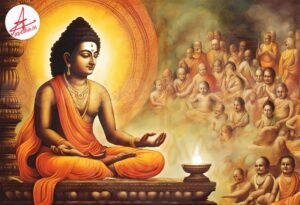Jainism is one of the oldest surviving religions, originating in ancient India.
Non-violence (Ahimsa) is the foundational principle, extending to all life forms.
Jainism believes in the eternal soul (jiva) which is subject to rebirth.
Actions, thoughts, and words influence future experiences through karma.
Liberation (Moksha) from the cycle of rebirth is the primary goal.
Renunciants practice strict vows of non-violence and other ethical principles.
Adherence to non-violence leads to strict vegetarianism.
Jains show deep reverence for all living beings.
Anekantavada emphasizes multiple perspectives on reality.
Agamas are central to Jain teachings and practices.
Jainism stands as one of the most ancient religions still practiced today, with its roots tracing back to ancient India. This profound tradition is distinguished by its rigorous commitment to non-violence, spiritual purity, and the belief in the eternal nature of the soul, or jiva. Let’s delve into the core aspects of Jainism to understand its profound impact on its followers and its unique position in the religious landscape.
Core Beliefs and Practices
At the heart of Jainism lies the principle of Ahimsa, or non-violence. This principle transcends mere abstention from physical harm and extends to avoiding injury to any living being, no matter how minuscule. This commitment to non-violence is not just a social or ethical stance but a profound spiritual directive that influences every action, thought, and word. Jains believe that all life is sacred and that causing harm, even unintentionally, accumulates negative karma which binds the soul to the cycle of rebirth.
The concept of the soul, or jiva, is central to Jain philosophy. Jiva is regarded as eternal, pure, and conscious. However, it remains trapped in the perpetual cycle of birth, death, and rebirth (samsara) due to accumulated karma. Karma, in Jainism, is more than just a ledger of deeds; it is a metaphysical substance that influences the soul’s journey through successive lives. Positive karma results in favorable rebirths and conditions, while negative karma perpetuates suffering and obstacles.
Achieving Moksha, or liberation, is the ultimate goal for Jains. This state of eternal bliss and freedom from the cycle of rebirth can only be attained through rigorous spiritual practice and the eradication of karma. The path to Moksha involves a disciplined approach to spiritual purity and ethical living, including ascetic practices for those who renounce worldly life. Ascetics, known as sādhu or sadhvi, adhere to strict vows that encompass non-violence, truthfulness, non-stealing, chastity, and renunciation of material possessions.
Vegetarianism is a natural extension of the principle of Ahimsa. Jains adhere to a strict vegetarian diet, reflecting their deep respect for all forms of life. This dietary practice is part of a broader ethos of minimizing harm and living in harmony with the environment.
Philosophy and Ethics
Jain philosophy introduces complex and nuanced perspectives on reality and knowledge. Anekantavada, or the doctrine of non-absolutism, posits that reality is multifaceted and can be understood from multiple viewpoints. This principle encourages openness to various perspectives and fosters a tolerant and pluralistic approach to truth.
Syadvada, or the doctrine of “maybe,” emphasizes the relativity of knowledge. It acknowledges that human perception and understanding are limited and that absolute knowledge is elusive. This perspective encourages humility and intellectual openness, recognizing that different perspectives can offer partial truths.
Aparigraha, or non-possessiveness, advocates for minimizing material attachments and possessions. This principle is integral to Jain ethics and supports a lifestyle of simplicity and contentment, free from the burdens of excessive accumulation.
Sacred Texts and Sites
The Agamas are the foundational scriptures of Jainism, encompassing teachings on philosophy, ethics, and rituals. These texts are revered for their comprehensive coverage of Jain thought and practice, guiding followers in their spiritual journey.
The Tirthankaras, revered spiritual teachers, are central figures in Jainism. There are 24 Tirthankaras, each believed to have achieved enlightenment and provided a path for others to follow towards liberation. Their lives and teachings are commemorated through pilgrimage to sacred sites associated with their lives.
Communities and Practices
Jainism is divided into two major sects: Digambaras and Śvētāmbaras. The primary distinction between these sects lies in their interpretations of ascetic practices and views on the nature of the soul. Despite their differences, both sects share a common foundation in Jain principles and ethics.
Most Jains are laypersons who integrate Jain teachings into their daily lives, observing ethical practices and participating in religious activities. Festivals and rituals play a significant role in community life, celebrating important events and teachings related to the Tirthankaras.
Jainism’s emphasis on non-violence, respect for all life, and the pursuit of spiritual purity continues to influence its adherents and remains a profound part of the religious and philosophical landscape of India and beyond.








